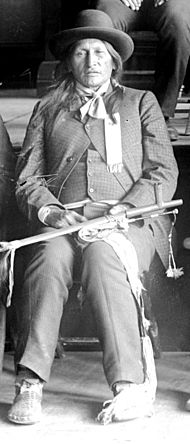Spotted Elk facts for kids
Quick facts for kids
Spotted Elk
|
|
|---|---|
| Heȟáka Glešká | |

Spotted Elk in 1888
|
|
| Miniconjou, Lakota Sioux leader | |
| Preceded by | Lone Horn (Heh-won-ge-chat or Ha-wón-je-tah – aka One Horn) |
| Personal details | |
| Born | 1826 (approx) |
| Died | December 29, 1890 (aged 64 approx) Wounded Knee Creek, Pine Ridge Indian Reservation (Lakota:Chankwe Opi Wakpala, Wazí Aháŋhaŋ Oyáŋke), South Dakota, U.S. |
| Cause of death | Killed, Wounded Knee Massacre |
| Resting place | Wounded Knee Monument, Wounded Knee Creek |
| Parent | Lone Horn (father) |
| Nickname | Big Foot (Si Tȟaŋka) |
Spotted Elk (Lakota: Uŋpȟáŋ Glešká, sometimes spelled OH-PONG-GE-LE-SKAH or Hupah Glešká: 1826 approx – December 29, 1890), was a chief of the Miniconjou, Lakota Sioux. He was a son of Miniconjou chief Lone Horn and became a chief upon his father's death. He was a highly renowned chief with skills in war and negotiations. A United States Army soldier, at Fort Bennett, coined the nickname Big Foot (Si Tȟáŋka) – not to be confused with Oglala Big Foot (also known as Ste Si Tȟáŋka and Chetan keah).
In 1890, he was killed by the U.S. Army at Wounded Knee Creek, Pine Ridge Indian Reservation (Chankwe Opi Wakpala, Wazí Aháŋhaŋ Oyáŋke), South Dakota, USA with at least 150 members of his tribe, in what became known as the Wounded Knee Massacre.
Contents
Early life
Spotted Elk (Lakota: Uŋpȟáŋ Glešká) was born about 1826, the son of Lakota Sioux chief Lone Horn (Heh-won-ge-chat). His family belonged to the Miniconjou ("Planters by the River") subgroup of the Teton Lakota (Sioux). In 1877, Spotted Elk became the chief of his tribe upon his father's death at the age of 87.
Chief Spotted Elk
Skillful diplomat
As chief, Spotted Elk (who later became known by the name of 'Big Foot' or Sitȟáŋka), was considered a great man of peace. He was best known among his people for his political and diplomatic successes. He was skilled at settling mass quarrels and was often in great demand among other Teton bands.
Sitting Bull and Crazy Horse alliance
During the 1870s, Spotted Elk allied his tribe against the US Army, together with Sitting Bull (Lakota: Tȟatȟáŋka Íyotake), Crazy Horse (Lakota:Tȟašúŋke Witkó) and Touch the Clouds (Lakota:Maȟpíya Ičáȟtagya). Spotted Elk saw no major action during the Great Sioux War of 1876-77. However, his tribe – the Miniconjou, Lakota Sioux – suffered during the war, after which they surrendered.
Reservation placement
Following the Sioux Wars, the government placed the Miniconjou on the Cheyenne River Indian Reservation, South Dakota. Spotted Elk encouraged adaptation to reservation life, by way of developing sustainable agriculture and building schools for Lakota children. He was amongst the first American Indians to raise corn in accordance with government standards. Spotted Elk also advocated a peaceful attitude toward white settlers.
Ghost Dance conversion and evangelism
New religious movement
Due to poor living conditions on the reservations, the Lakota struggled greatly to survive. In some cases, Indian agents were corrupt, undertaking fraud and stealing Lakota supplies/annuities. By 1889 they were in despair, and looked for change.
The radical solution came in the form of the Ghost Dance movement, a new religion initiated by Paiute prophet Wovoka. Spotted Elk and the Lakota became among the most enthusiastic believers in the 'Ghost Dance' ceremony when it arrived among them, in the spring of 1890. Although governmental reservation rules outlawed the practice of the religion, the movement swept like a wildfire through the camps and local Indian agents reacted with alarm. Some agents successfully suppressed the dancers, while others called for federal troops to restore order.
Chief Red Cloud offers refuge
After 20 December 1890, when Sitting Bull was killed on Standing Rock Reservation, his followers fled for refuge at the camp of his former-ally and half-brother, Chief Spotted Elk. Fearing arrest and government reprisals against his band, Spotted Elk led his band south to the Pine Ridge Reservation, South Dakota, at the invitation of Chief Red Cloud (Lakota: Maȟpíya Lúta). Red Cloud hoped that his fellow chief could help make peace. Seeking safety, flying a white flag and with no intention of fighting, Spotted Elk contracted pneumonia on the journey to Pine Ridge.
Death at Wounded Knee Massacre
Peaceful surrender
On December 28, 1890, Maj. Samuel M. Whitside's battalion of the 7th Cavalry intercepted the Lakota. Ill with pneumonia, Spotted Elk surrendered peacefully, with his band; the cavalry took them into custody, escorting them to a campsite near Wounded Knee Creek, Pine Ridge, where they were to set camp. The site was already established with a store and several log houses.
Wounded Knee Massacre
The night before the massacre, Col. James W. Forsyth arrived at Wounded Knee Creek and ordered his men to position four Hotchkiss cannons around the area in which the Lakota had been forced to camp.
On the morning of December 29, 1890, Forsyth's soldiers entered the camp and demanded that the Lakota give up their weapons. In the ensuing confrontation, a firearm was discharged. It was later believed to have been by a deaf man, Black Coyote, who presumably did not hear the command to put down his rifle. A large gun fight quickly ensued. The US forces killed more than 250 Lakota, mostly non-combatants (women and children) and Spotted Elk was among those killed.
See also
 In Spanish: Si Tanka para niños
In Spanish: Si Tanka para niños

